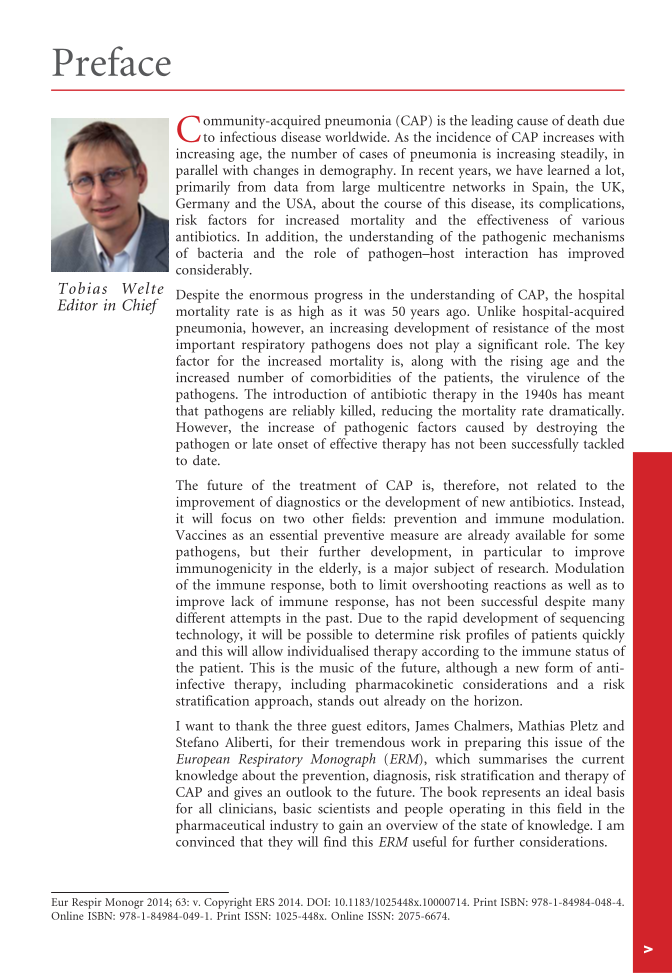Preface C ommunity-acquired pneumonia (CAP) is the leading cause of death due to infectious disease worldwide. As the incidence of CAP increases with increasing age, the number of cases of pneumonia is increasing steadily, in parallel with changes in demography. In recent years, we have learned a lot, primarily from data from large multicentre networks in Spain, the UK, Germany and the USA, about the course of this disease, its complications, risk factors for increased mortality and the effectiveness of various antibiotics. In addition, the understanding of the pathogenic mechanisms of bacteria and the role of pathogen–host interaction has improved considerably. Despite the enormous progress in the understanding of CAP, the hospital mortality rate is as high as it was 50 years ago. Unlike hospital-acquired pneumonia, however, an increasing development of resistance of the most important respiratory pathogens does not play a significant role. The key factor for the increased mortality is, along with the rising age and the increased number of comorbidities of the patients, the virulence of the pathogens. The introduction of antibiotic therapy in the 1940s has meant that pathogens are reliably killed, reducing the mortality rate dramatically. However, the increase of pathogenic factors caused by destroying the pathogen or late onset of effective therapy has not been successfully tackled to date. The future of the treatment of CAP is, therefore, not related to the improvement of diagnostics or the development of new antibiotics. Instead, it will focus on two other fields: prevention and immune modulation. Vaccines as an essential preventive measure are already available for some pathogens, but their further development, in particular to improve immunogenicity in the elderly, is a major subject of research. Modulation of the immune response, both to limit overshooting reactions as well as to improve lack of immune response, has not been successful despite many different attempts in the past. Due to the rapid development of sequencing technology, it will be possible to determine risk profiles of patients quickly and this will allow individualised therapy according to the immune status of the patient. This is the music of the future, although a new form of anti- infective therapy, including pharmacokinetic considerations and a risk stratification approach, stands out already on the horizon. I want to thank the three guest editors, James Chalmers, Mathias Pletz and Stefano Aliberti, for their tremendous work in preparing this issue of the European Respiratory Monograph (ERM), which summarises the current knowledge about the prevention, diagnosis, risk stratification and therapy of CAP and gives an outlook to the future. The book represents an ideal basis for all clinicians, basic scientists and people operating in this field in the pharmaceutical industry to gain an overview of the state of knowledge. I am convinced that they will find this ERM useful for further considerations. Tobias Welte Editor in Chief Eur Respir Monogr 2014 63: v. Copyright ERS 2014. DOI: 10.1183/1025448x.10000714. Print ISBN: 978-1-84984-048-4. Online ISBN: 978-1-84984-049-1. Print ISSN: 1025-448x. Online ISSN: 2075-6674. v
